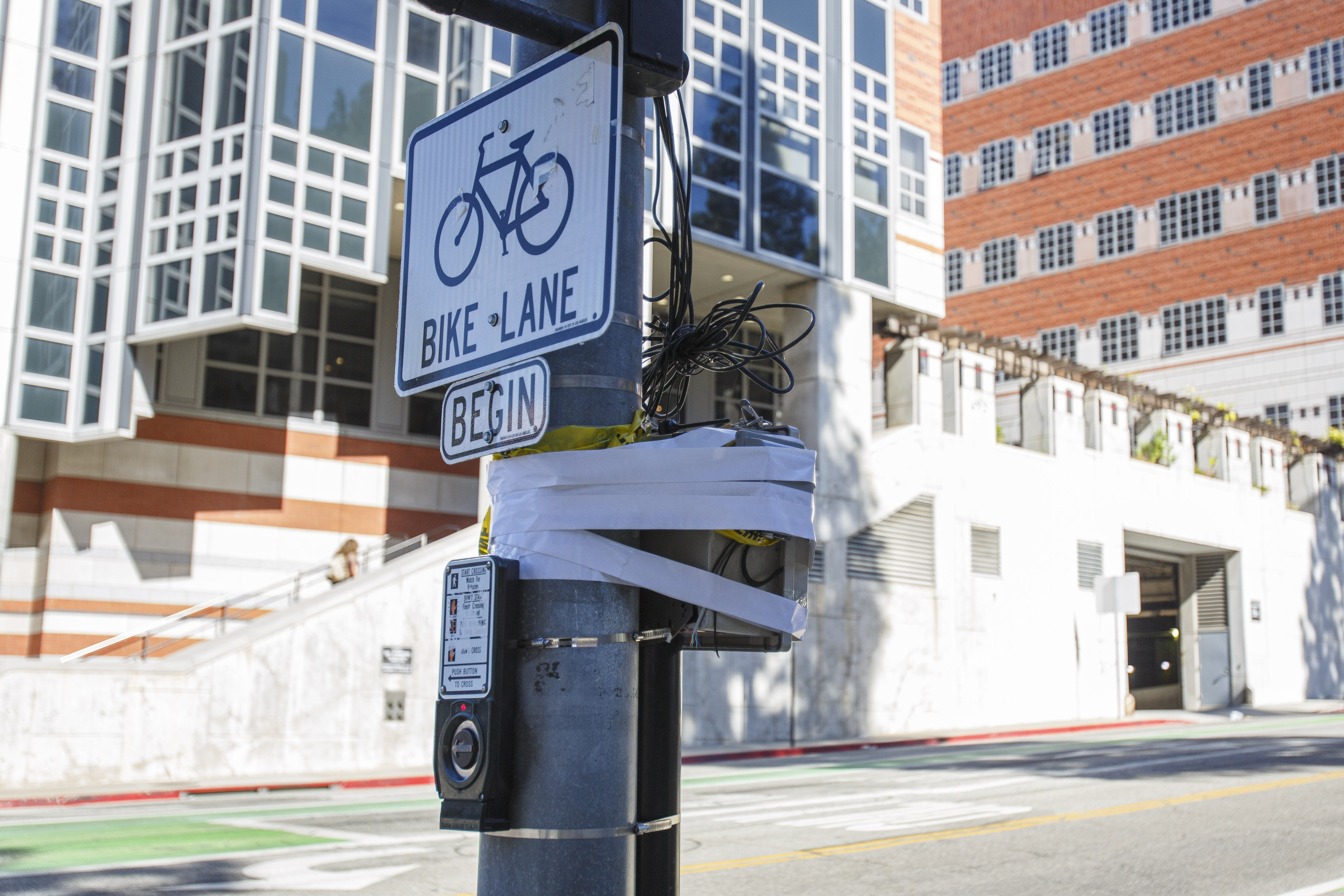UCLA Mobility Lab works to decrease traffic and improve safety in Westwood

A traffic light at the intersection of Charles E. Young Drive and Westwood Plaza is pictured with electrical equipment taped up to it. The light is part of UCLA’s Smart Intersection, a project under the UCLA Mobility Lab that analyzes traffic patterns to improve autonomous driving. (Ella Greenberg Winnick/Daily Bruin staff)
By Kai Nikchevich
Nov. 26, 2023 6:02 p.m.
This post was updated Nov. 26 at 11:29 p.m.
On any given day, thousands of people walk past a traffic light next to the Gonda Neuroscience and Genetics Research Center. But some mornings, that traffic light is surrounded by a web of wires, computers and people.
This intersection isn’t just any intersection – it’s the UCLA Smart Intersection – and the people there are members of the UCLA Mobility Lab.
The lab works with UCLA Transportation to reduce traffic and increase safety throughout Westwood, said Jiaqi Ma, the lab’s director and an associate professor of civil and environmental engineering. Zhaoliang Zheng, a doctoral student in the lab, said the team uses both virtual simulations and hardware to analyze the flow of vehicles and pedestrians – making the lab one of the first in the field to combine virtual and physical data in this way.
Zheng said one of the challenges of the lab’s work is a lack of precedent when it comes to real-life experiments on road traffic.
“There’s no papers that we can refer to because no one has done the real experiment before,” he said. “They’re only doing the simulation.”
Once enough traffic data is collected, the findings can train autonomous vehicles, allowing them to make better decisions, said Xin Xia, a researcher in the lab.
Zheng said a combination of sensors mounted on cars driven by researchers through the intersection, as well as on the street lights surrounding the area, help to measure the flow of pedestrians and vehicles from multiple perspectives and allow the lab to learn more about objects surrounding the vehicle. This data can reveal patterns, such as unexpected traffic or situations that occur in the car’s blind spots – data that is then relayed to the “smart” car to improve the car’s awareness of its environment, Xia said.
Ma said interactions between the practical sensors used in the lab lead to real-world applications. According to the lab’s website, its findings enable the lab to equip self-driving cars with better decision-making skills and the ability to drive without maps.
“We always think that there’s a physical world and there’s an artificial world, so they need to interact with each other,” Ma said. “We can … simulate many, many different scenarios to try to understand what is the best strategy moving forward.”
Like the varied nature of the data the lab collects, members of the lab also come from many academic disciplines. Ma said this academic diversity is essential to successfully gather results, as having many lab members can enable the team to work in all areas – on the ground at the intersection, in the cars and in the remote lab doing data synthesis.
“Some research labs, … you work on it yourself and that’s it. But our lab is very collaborative,” he said. “They are (from) all sorts of backgrounds: some civil, some electrical, some mechanical, some computer science (engineering).”
Zheng, whose work centers on the data-collecting cars and their attached equipment, said his background in robotics and electrical engineering has influenced his role in the lab, as the cars are like robots but on a larger scale.
However, the complexity of the lab’s research entails certain challenges. Zheng said hardware and computer bugs are common problems and that communication between the team can be difficult because of the amount of data that must be collected and the size of the lab, which includes nearly 20 people.
Additionally, Zheng said most of the equipment used in the experiments is created by the lab and tested at the intersection. He added that while a typical day might start at 9:30 a.m., data collection might not begin until noon because of the time required to install the equipment on the car.
“Every time we have to put this heavy rack along with its sensors on top of our own vehicle, but that takes a really long time,” Zheng said. “It takes about the whole afternoon to finish everything, and lots of times we have lots of hardware issues, connection issues, and we don’t even know what the bug is.”
Although the process of building, collecting data and adjusting hardware is time-consuming, it yields useful information, Zheng said. Ma added that the constant data collection also allows the digital simulation model of the intersection to grow on its own, becoming more refined and responsive to traffic as it learns from the data and itself.
Ma also said that by building smart intersections like this one, the lab can explore the relationship between different scenarios and traffic in the real world, taking into account unexpected factors such as large vehicles that block visibility or unexpected pedestrians that the simulations cannot account for.
“We can do analysis of emerging mobility systems and can also in many cases, with the old simulations based on these things, evaluate what’s going to happen,” Ma said.
Eventually, the lab hopes to expand its virtual simulation concept across Westwood to maximize its potential reach, Ma said.
“Doing field experiments is always challenging,” Ma said. “We believe that to develop a solution, you really have to test in a real-world environment to prove it.”

